Index to Flowers in the Malpighiales
Family: Euphorbiaceae (Spurge Family)
Euphorbia burmannii Strand Milkbush viewtopic.php?f=248&t=3735&p=170569#p175151
Euphorbia dregeana Elephant’s Bush viewtopic.php?f=248&t=3735&p=172027#p172027
Euphorbia gregaria Karas Euphorbia viewtopic.php?f=248&t=3735&p=170569#p172029
Euphorbia heptagona Milk Barrel viewtopic.php?p=229278#p229278
Euphorbia mauritanica Yellow Pencil Milk Bush, Golden Spurge viewtopic.php?p=195558#p195558
Euphorbia virosa Candelabra Euphorbia viewtopic.php?p=296606#p296606
Family: Passifloraceae
Tricliceras schinzii laceratum Lion's Eye viewtopic.php?f=248&t=3735&p=170569#p172030
Africa Wild Flower Book - Order Malpighiales
Moderator: Klipspringer
Re: Africa Wild Flower Book - Order Malpighiales
Elephant’s Bush Euphorbia dregeana (Bergmelkbos, Dikboud)
Order: Malpighiales. Family: Euphorbiaceae
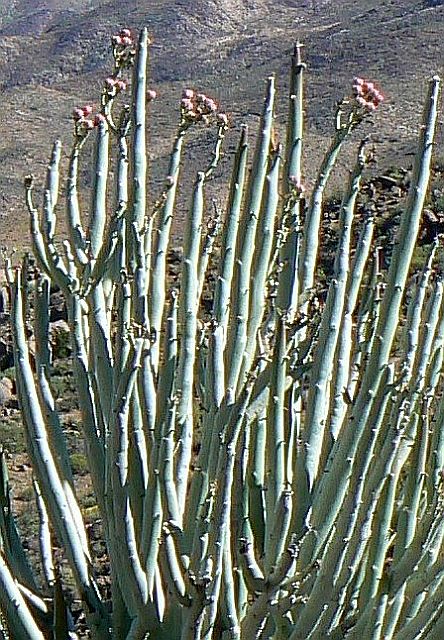

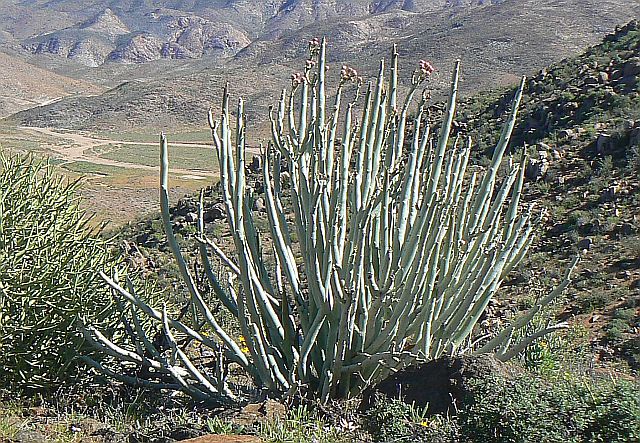
Richtersveld National Park
Description
Euphorbia dregeana is a succulent shrub branching much at the base into a multitude of erect cylindrical green stems, radiating out to form a rounded bush. It is the tallest of the narrow-stemmed euphorbias in this area. lt can grow up to two metres high and bears a large inflorescence. The stems are spineless, smooth, often thicker than 2 cm across and covered in markings all the way up where the small (8 mm long) and short-lived leaves had fallen off. Flowering stems are thinner with the flowers bunched at the tips.
The flowers are yellow with two rounded petal-like lobes encircling the emerging six-sectioned seed capsule. The capsule turns red when developed and brown later when it dries. The plant exudes the characteristic Euphorbia white latex, sometimes called wolves’ milk.
Distribution
Namibia and South Africa (Northern Cape). Euphorbia dregeana plants grow in the Richtersveld, Namaqualand and in Namibia.
Habitat
Rocky areas in Succulent Karoo.


Richtersveld National Park
Order: Malpighiales. Family: Euphorbiaceae



Richtersveld National Park
Description
Euphorbia dregeana is a succulent shrub branching much at the base into a multitude of erect cylindrical green stems, radiating out to form a rounded bush. It is the tallest of the narrow-stemmed euphorbias in this area. lt can grow up to two metres high and bears a large inflorescence. The stems are spineless, smooth, often thicker than 2 cm across and covered in markings all the way up where the small (8 mm long) and short-lived leaves had fallen off. Flowering stems are thinner with the flowers bunched at the tips.
The flowers are yellow with two rounded petal-like lobes encircling the emerging six-sectioned seed capsule. The capsule turns red when developed and brown later when it dries. The plant exudes the characteristic Euphorbia white latex, sometimes called wolves’ milk.
Distribution
Namibia and South Africa (Northern Cape). Euphorbia dregeana plants grow in the Richtersveld, Namaqualand and in Namibia.
Habitat
Rocky areas in Succulent Karoo.


Richtersveld National Park
Re: Africa Wild Flower Book - Order Malpighiales
Karas Euphorbia Euphorbia gregaria (Karasmelkbos)
Order: Malpighiales. Family: Euphorbiaceae

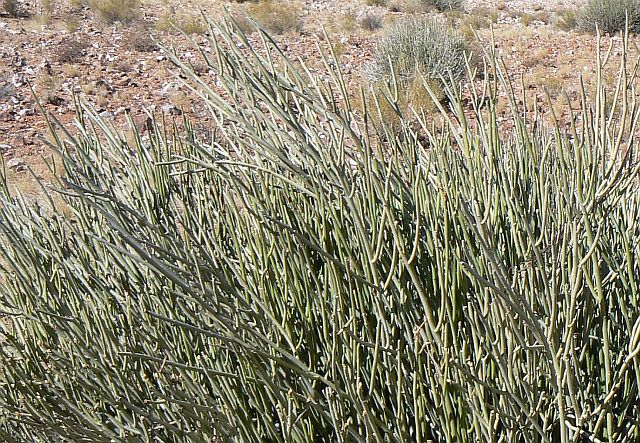
Augrabies Falls National Park, Northern Cape
Description
Many-stemmed, spineless, leafless, succulent shrub, very small 0.5-2 m high with vertically compressed stems (internodes not visible). Main stem reduced and barely visible above ground level. Many green branches, round in cross-section. Leaves only on new growth. The fruit is a rounded capsule on a recurved stalk, up to 16 mm in diameter.
Distribution
Southern Namibia, Northern Cape in South Africa. Common in the desert regions along the Orange River.
Habitat
On hillslopes and plains, on sandy, gravel or rocky substrates.
Links: AZ: Damara-Wolfsmilch und Karas-Wolfsmilch
Order: Malpighiales. Family: Euphorbiaceae


Augrabies Falls National Park, Northern Cape
Description
Many-stemmed, spineless, leafless, succulent shrub, very small 0.5-2 m high with vertically compressed stems (internodes not visible). Main stem reduced and barely visible above ground level. Many green branches, round in cross-section. Leaves only on new growth. The fruit is a rounded capsule on a recurved stalk, up to 16 mm in diameter.
Distribution
Southern Namibia, Northern Cape in South Africa. Common in the desert regions along the Orange River.
Habitat
On hillslopes and plains, on sandy, gravel or rocky substrates.
Links: AZ: Damara-Wolfsmilch und Karas-Wolfsmilch
-
Klipspringer
- Global Moderator
- Posts: 5858
- Joined: Sat Sep 14, 2013 12:34 pm
- Country: Germany
- Contact:
Re: Africa Wild Flower Book - Order Malpighiales
Lion's Eye Tricliceras schinzii laceratum
Order: Malpighiales. Family: Passifloraceae. Subfamily: Turneroideae
Southern Kruger National Park, Dec 2020 © RogerFraser
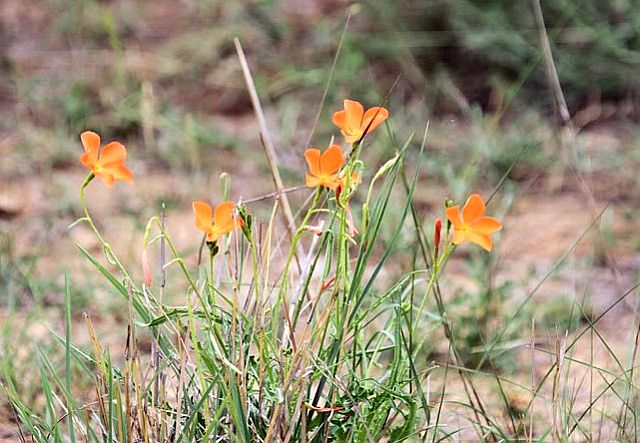 © leachy
© leachy
 © leachy
© leachy
Kruger National Park
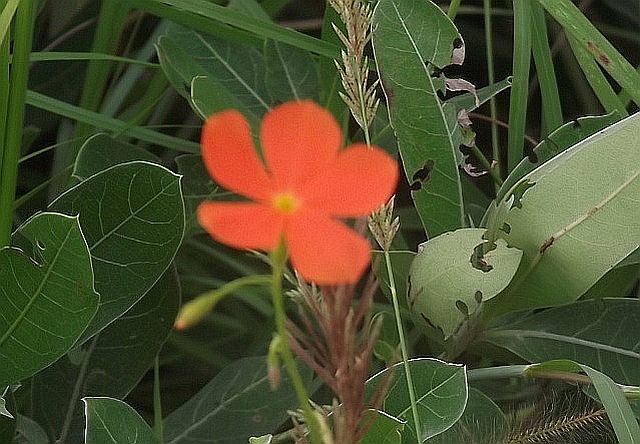 © mposthumus
© mposthumus
Kruger National Park, around Pretoriuskop
Description
A perennial herb, 15 to 30 cm high, sprouting annually from a perennial taproot. Covered with coarse, greenish bristles.
Leaves narrow, deeply lobed and toothed. Flowers (August to March) in racemes of few flowers, petals bright orange, 40 mm in diameter. Each flower lasts only one day, but the flowering period extends over a long period. It develops minutely bristly fruits.
occurs more commonly in the Lowveld region.
Similar species: T. longipedunculatum occurs only in the higher altitude areas but also down to the tallus zones of the escarpment.
T. longipedunculatum has spreading reddish hairs, only slightly toothed leaves and hairless fruits.
Distribution
South Africa (lowveld: Mpumalanga and Limpopo), eSwatini.
Habitat
Woodland and grassland in the lowveld.
Links:
https://www.operationwildflower.org.za/ ... -il-5-7282
 © arks
© arks
 © arks
© arks
Kruger National Park, S36
Order: Malpighiales. Family: Passifloraceae. Subfamily: Turneroideae
Southern Kruger National Park, Dec 2020 © RogerFraser
 © leachy
© leachy © leachy
© leachyKruger National Park
 © mposthumus
© mposthumusKruger National Park, around Pretoriuskop
Description
A perennial herb, 15 to 30 cm high, sprouting annually from a perennial taproot. Covered with coarse, greenish bristles.
Leaves narrow, deeply lobed and toothed. Flowers (August to March) in racemes of few flowers, petals bright orange, 40 mm in diameter. Each flower lasts only one day, but the flowering period extends over a long period. It develops minutely bristly fruits.
occurs more commonly in the Lowveld region.
Similar species: T. longipedunculatum occurs only in the higher altitude areas but also down to the tallus zones of the escarpment.
T. longipedunculatum has spreading reddish hairs, only slightly toothed leaves and hairless fruits.
Distribution
South Africa (lowveld: Mpumalanga and Limpopo), eSwatini.
Habitat
Woodland and grassland in the lowveld.
Links:
https://www.operationwildflower.org.za/ ... -il-5-7282
 © arks
© arks © arks
© arksKruger National Park, S36
Re: Africa Wild Flower Book - Order Malpighiales
Strand Milkbush Euphorbia burmannii (Steenbokbos, Bloumelkbos)
Order: Malpighiales. Family: Euphorbiaceae
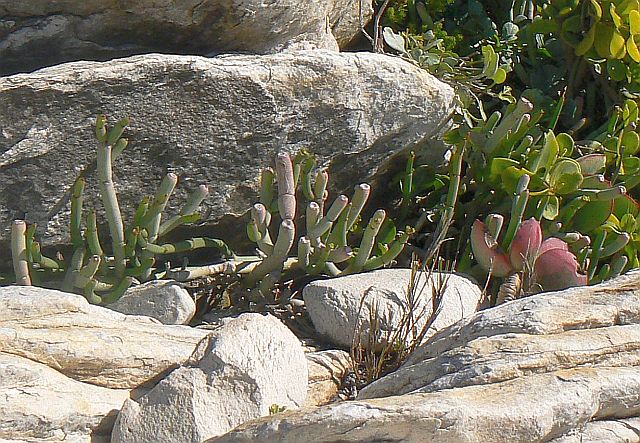
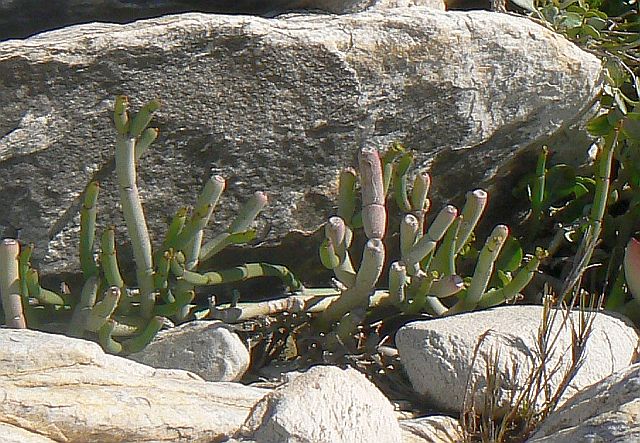
Cape Agulhas
Description
Euphorbia burmannii is a multi-stemmed succulent shrublet, 15-100 cm, with cylindrical green stems with short-lived leaves on the young growth at the tips. In dry conditions pieces may drop off the plant and take root if conditions allow. It produces yellow flowers in winter and spring.
The stems are smooth and hairless. The small new leaves found at the top on the newly grown stem bits for a short period only, have already come and gone for this season. The flowers are also gone. Some dry or drying seed capsules are to be seen on the remaining stalks.
Distribution
Eastern Cape, Little Karoo, Great Karoo and the west coast northwards through Namaqualand, the Richtersveld and into Namibia.
Habitat
Semi-arid coastal fynbos. Common on sandy flats along the coast.
Order: Malpighiales. Family: Euphorbiaceae


Cape Agulhas
Description
Euphorbia burmannii is a multi-stemmed succulent shrublet, 15-100 cm, with cylindrical green stems with short-lived leaves on the young growth at the tips. In dry conditions pieces may drop off the plant and take root if conditions allow. It produces yellow flowers in winter and spring.
The stems are smooth and hairless. The small new leaves found at the top on the newly grown stem bits for a short period only, have already come and gone for this season. The flowers are also gone. Some dry or drying seed capsules are to be seen on the remaining stalks.
Distribution
Eastern Cape, Little Karoo, Great Karoo and the west coast northwards through Namaqualand, the Richtersveld and into Namibia.
Habitat
Semi-arid coastal fynbos. Common on sandy flats along the coast.
Re: Africa Wild Flower Book - Order Malpighiales
Yellow Pencil Milk Bush, Golden Spurge Euphorbia mauritanica (Geel Melkbos)
Order: Malpighiales. Family: Euphorbiaceae
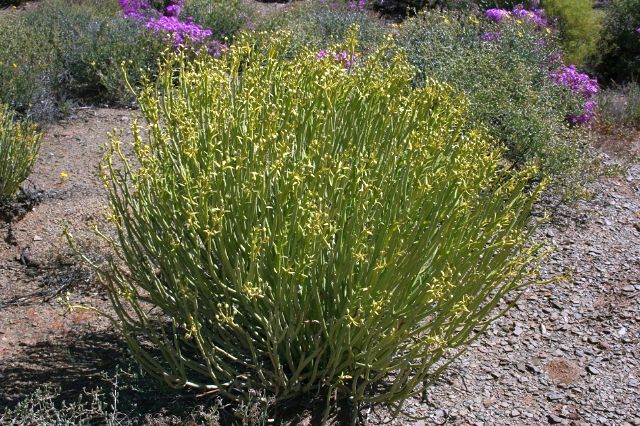 © Tina
© Tina
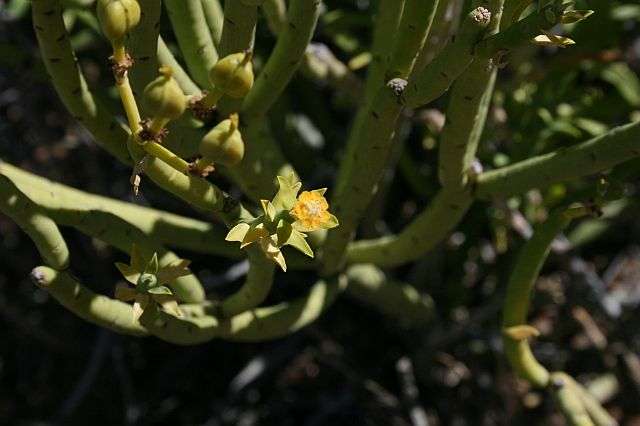 © Tina
© Tina
Euphorbia mauritanica mauritanica in the Tankwa Karoo National Park
Description
Euphorbia mauritanica is a monoecious, spineless succulent bush. A rounded shrub, densely branched, usually 1 m high, sometimes up to 2 m in height and usually wider in diameter. Branches arise from a thick root stock, with relatively few side branches. Pencil-thin branches are cylindrical and smooth, yellowish green, fleshy, marked with alternate leaf scars. Leaves are deciduous, crowded on the youngest branches. This plant produces yellow cyathia (the term used for the inflorescence of euphorbias) that are in a compact group at the end of each young branch. A male cyathium is surrounded by 5 to 7 bisexual cyathia on a short terminal branch. Glands 5-8, bright yellow. Pistillate flower exserted from the involucre on a curved pedicel. The flowering period is between August and October. When the plant is injured, it produces milky sap at the cut.
Distribution
This plant occurs extensively throughout the Northern Cape, Western Cape, Eastern Cape, Free State, KwaZulu-Natal, as well as in Namibia. This is the most widely distributed of all the South African shrubby euphorbias.
Taxonomy
Euphorbia mauritanica is variable and a number of varieties have been described:
Euphorbia mauritanica foetens has thick succulent stems; southern Namibia (Aus)
Euphorbia mauritanica lignosa has woody branches; coastal, from Lüderitz Bay to Northern Namaqualand
Euphorbia mauritanica mauritanica
Euphorbia mauritanica minor is smaller, slightly glaucous
Euphorbia mauritanica namaquensis
Habitat
Euphorbia mauritanica grows very well in dry climates and in coastal as well as inland areas with colder winters. It is found in most of southern Africa, especially the Succulent Karroo, where it is frequently dominant in valleys and hillsides.
Links: Namib Rand Herbarium; Doreen Court: Succulent Flora of Southern Africa
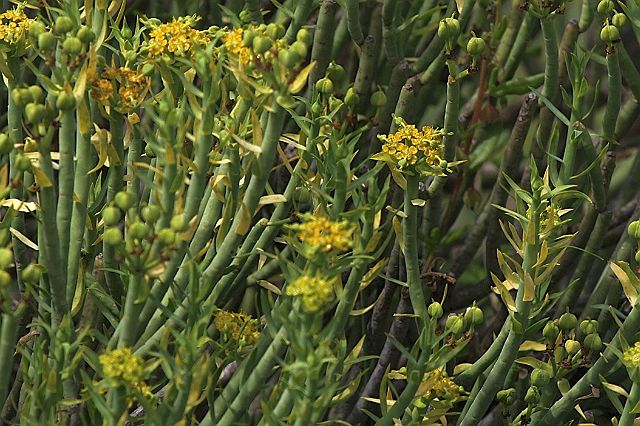 © Tina
© Tina
West Coast National Park
Order: Malpighiales. Family: Euphorbiaceae
 © Tina
© Tina © Tina
© TinaEuphorbia mauritanica mauritanica in the Tankwa Karoo National Park
Description
Euphorbia mauritanica is a monoecious, spineless succulent bush. A rounded shrub, densely branched, usually 1 m high, sometimes up to 2 m in height and usually wider in diameter. Branches arise from a thick root stock, with relatively few side branches. Pencil-thin branches are cylindrical and smooth, yellowish green, fleshy, marked with alternate leaf scars. Leaves are deciduous, crowded on the youngest branches. This plant produces yellow cyathia (the term used for the inflorescence of euphorbias) that are in a compact group at the end of each young branch. A male cyathium is surrounded by 5 to 7 bisexual cyathia on a short terminal branch. Glands 5-8, bright yellow. Pistillate flower exserted from the involucre on a curved pedicel. The flowering period is between August and October. When the plant is injured, it produces milky sap at the cut.
Distribution
This plant occurs extensively throughout the Northern Cape, Western Cape, Eastern Cape, Free State, KwaZulu-Natal, as well as in Namibia. This is the most widely distributed of all the South African shrubby euphorbias.
Taxonomy
Euphorbia mauritanica is variable and a number of varieties have been described:
Euphorbia mauritanica foetens has thick succulent stems; southern Namibia (Aus)
Euphorbia mauritanica lignosa has woody branches; coastal, from Lüderitz Bay to Northern Namaqualand
Euphorbia mauritanica mauritanica
Euphorbia mauritanica minor is smaller, slightly glaucous
Euphorbia mauritanica namaquensis
Habitat
Euphorbia mauritanica grows very well in dry climates and in coastal as well as inland areas with colder winters. It is found in most of southern Africa, especially the Succulent Karroo, where it is frequently dominant in valleys and hillsides.
Links: Namib Rand Herbarium; Doreen Court: Succulent Flora of Southern Africa
 © Tina
© TinaWest Coast National Park
Re: Africa Wild Flower Book - Order Malpighiales
Milk Barrel Euphorbia heptagona (Donkienoorsdoring, Klipnoors)
Order: Malpighiales. Family: Euphorbiaceae
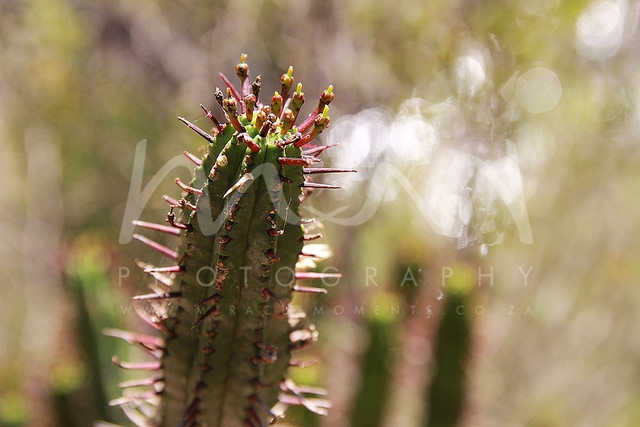 © Michael de Nysschen
© Michael de Nysschen
Description
A spiny rounded shrub, 60-130 cm tall, much branched at the base and above. The species is dioecious; male and female flowers occurring on separate plants. The “spines” are sterile dry peduncles. Spines solitary, subulate, flower-bearing. The long spines on the ridges are light brown or yellow to reddish brown when they are young on the stem tops. Stems roundish, upright, succulent, with six to ten ridges. Flowering occurs from June to September. The cyathia are green, yellow-green or reddish.
Distribution
South African endemic. Eastern Cape, Western Cape, from Touwsrivier to Montagu and Jansenville.
Habitat
Nama Karoo, Succulent Karoo. On stony, north-facing slopes, often on clay.
Order: Malpighiales. Family: Euphorbiaceae
 © Michael de Nysschen
© Michael de NysschenDescription
A spiny rounded shrub, 60-130 cm tall, much branched at the base and above. The species is dioecious; male and female flowers occurring on separate plants. The “spines” are sterile dry peduncles. Spines solitary, subulate, flower-bearing. The long spines on the ridges are light brown or yellow to reddish brown when they are young on the stem tops. Stems roundish, upright, succulent, with six to ten ridges. Flowering occurs from June to September. The cyathia are green, yellow-green or reddish.
Distribution
South African endemic. Eastern Cape, Western Cape, from Touwsrivier to Montagu and Jansenville.
Habitat
Nama Karoo, Succulent Karoo. On stony, north-facing slopes, often on clay.
Re: Africa Wild Flower Book - Order Malpighiales
Candelabra Euphorbia, Poison Tree Euphorbia virosa (Boesmansgif, Gifboom)
Order: Malpighiales. Family: Euphorbiaceae
 © Bushveld Jock & PRWIN
© Bushveld Jock & PRWIN
 © Bushveld Jock & PRWIN
© Bushveld Jock & PRWIN
Richtersveld National Park
Description
A thorny succulent shrub, forming clumps. It usually grows up to 3 m with the main stem partly buried under the ground. The main stem gives rise to large branches 50–60 mm thick and over a metre in height. The main stem and branches are angled and have pairs of thorns at the edges. At first the thorns are dark red and shiny and then become grey. It produces yellow flowers at the tip of the stem followed by red fruit in late winter.
It has a highly poisonous milky sap which can cause blindness. It is known as the most poisonous of all euphorbias.
Distribution
Euphorbia virosa is found in the Richtersveld and western areas just south of the Orange River, in Namibia and Angola.
Habitat
It prefers the very dry and hot areas of southern Africa and is drought-tolerant. It is commonly found in sandy and stony regions associated with rugged hills and mountains.
Links: Succulent Flora of Southern Africa; SUCCULENT EUPHORBIAS FROM NAMIBIA; Tree Atlas of Namibia
Order: Malpighiales. Family: Euphorbiaceae
 © Bushveld Jock & PRWIN
© Bushveld Jock & PRWIN © Bushveld Jock & PRWIN
© Bushveld Jock & PRWINRichtersveld National Park
Description
A thorny succulent shrub, forming clumps. It usually grows up to 3 m with the main stem partly buried under the ground. The main stem gives rise to large branches 50–60 mm thick and over a metre in height. The main stem and branches are angled and have pairs of thorns at the edges. At first the thorns are dark red and shiny and then become grey. It produces yellow flowers at the tip of the stem followed by red fruit in late winter.
It has a highly poisonous milky sap which can cause blindness. It is known as the most poisonous of all euphorbias.
Distribution
Euphorbia virosa is found in the Richtersveld and western areas just south of the Orange River, in Namibia and Angola.
Habitat
It prefers the very dry and hot areas of southern Africa and is drought-tolerant. It is commonly found in sandy and stony regions associated with rugged hills and mountains.
Links: Succulent Flora of Southern Africa; SUCCULENT EUPHORBIAS FROM NAMIBIA; Tree Atlas of Namibia


